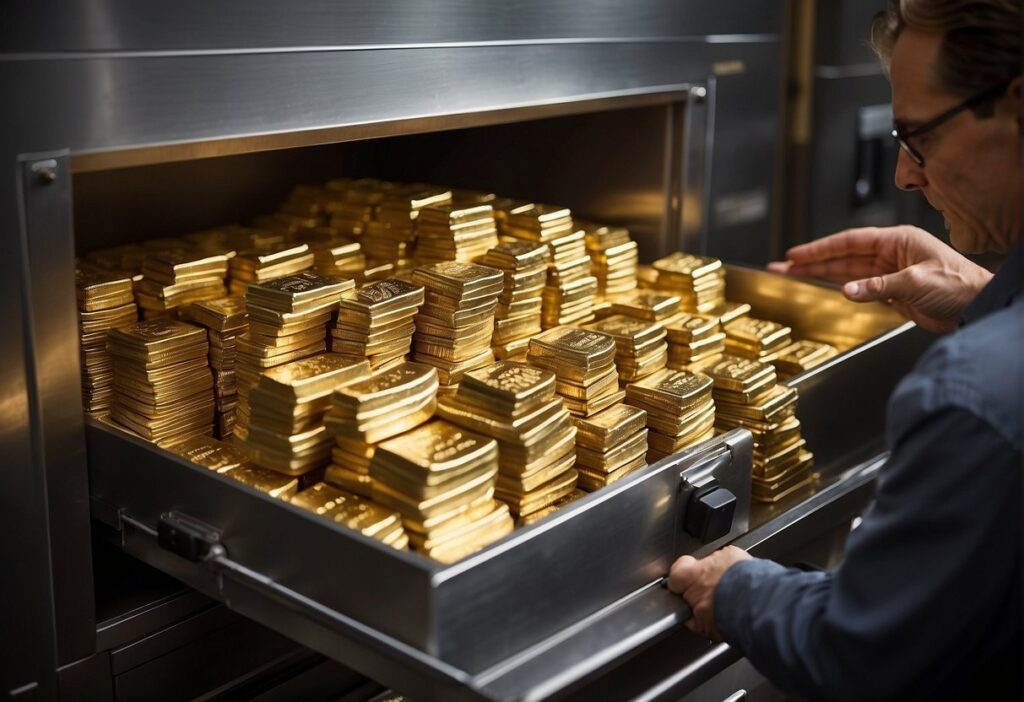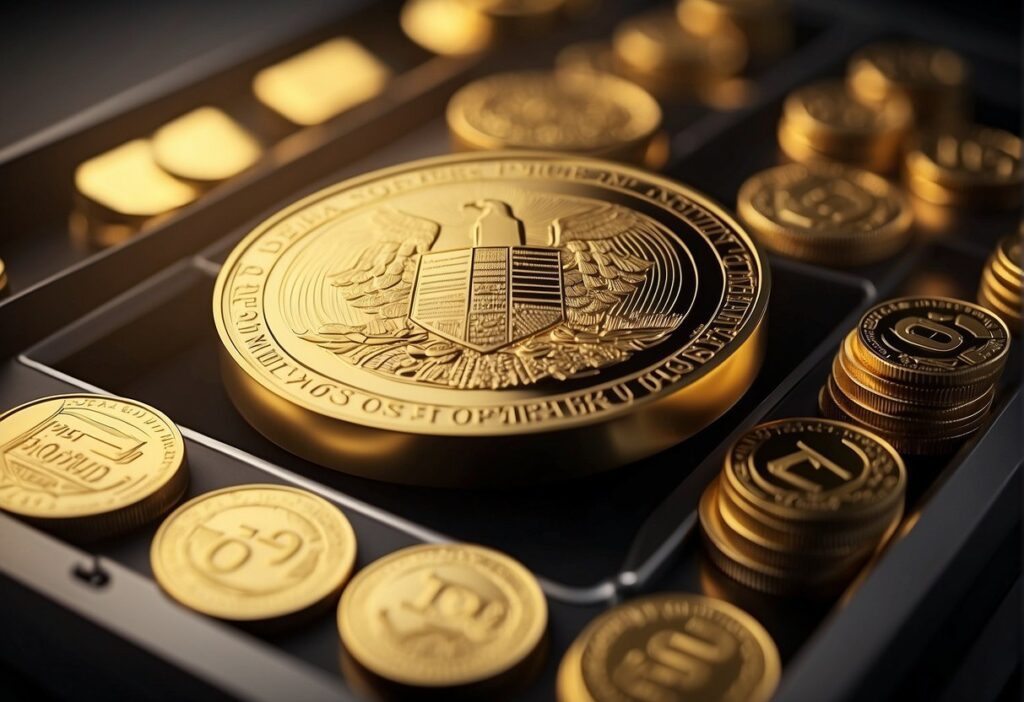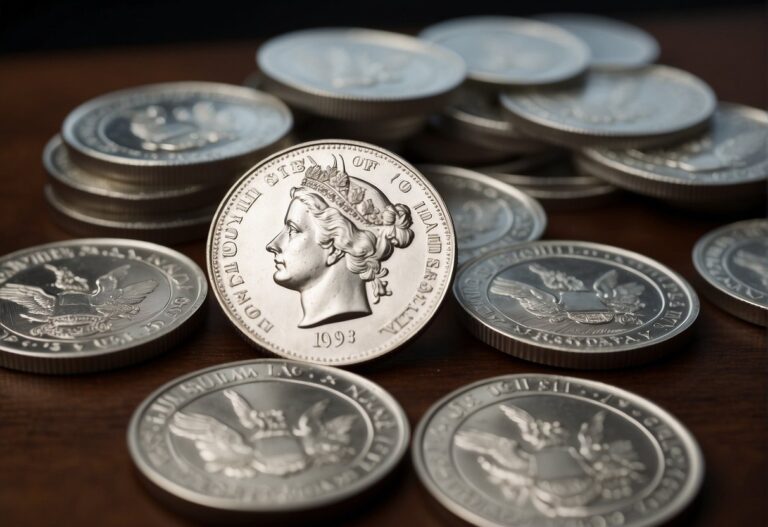A Precious Metals IRA Depository is a specialized storage facility where individuals can securely store the physical precious metals that are part of their Individual Retirement Accounts (IRAs).
These depositories provide a secure environment, protected by advanced security measures, and comply with Internal Revenue Service (IRS) regulations regarding storing such assets.
These facilities offer a crucial service for investors looking to include gold, silver, platinum, or palladium in their retirement portfolios.
Setting up and managing a Precious Metals IRA involves selecting a trustworthy depository. This decision is vital as it ensures the safekeeping of the physical assets that underpin the retirement investment.
These IRA-eligible precious metals are typically held in the form of coins or bullion, and each depository may offer different features, such as segregated or non-segregated storage, as well as varying fee structures and insurance policies, all of which should be considered when choosing the proper depository for one’s investment needs.
Gold IRA Depository Key Takeaways
- Precious Metals IRA Depositories specialize in securing physical metals for IRAs in compliance with IRS standards.
- Investors must carefully select a depository, considering security, compliance, and fee structures.
- Proper management of a Precious Metals IRA requires coordination with a custodian for financial oversight.
Understanding Precious Metals IRAs

Investment diversification is crucial, and a Precious Metals IRA offers a unique option to hold physical assets within a retirement account. They primarily aim to provide a hedge against inflation and market volatility.
Gold IRA Definition and Purpose
A Precious Metals IRA, often referred to as a gold IRA or silver IRA, is a type of self-directed IRA that permits the inclusion of physical precious metals like gold, silver, platinum, and palladium into a retirement account. These individual retirement accounts serve the dual purpose of providing retirement savings while capitalizing on the inherent stability that precious metals historically represent.
Holding these assets within an IRA utilizes the same tax-advantaged status as conventional and Roth IRAs but with the added benefit of owning tangible assets.
Types of Precious Metals IRAs
There are typically two main types of Precious Metals IRAs:
- Traditional Precious Metals IRA: Contributions are made with pre-tax dollars, investments grow tax-deferred, and taxes are paid only upon withdrawal.
- Roth Precious Metals IRA: These are funded with after-tax dollars, allowing for tax-free growth and withdrawal, provided certain conditions are met.
Both types allow investment in gold, silver, and other precious metals, subject to IRS purity standards. I want to point out that selecting a reputable IRA custodian and a qualified depository to store these assets securely is essential.
The Role of the IRS in Precious Metals IRAs

The Internal Revenue Service (IRS) has specific guidelines and regulations to govern Precious Metals IRAs, including adherence to standards for IRS-approved depositories and the physical precious metals that qualify for these accounts.
IRS Approval Process for Gold Depositories
Depositories that wish to store IRA assets must meet specific security and operational standards set by the IRS. IRS-approved depositories must ensure the safekeeping of the precious metals, which includes rigorous security measures, inventory controls, and financial stability.
This approval involves an application process where the depository must demonstrate their ability to comply with IRS standards.
Upon IRS review and satisfaction of the criteria, the depository can be considered an IRS-approved facility where individuals can store their IRA precious metals investments.
IRS Requirements for Physical Metals
The IRS has established minimum fineness requirements for precious metals to be eligible for a Precious Metals IRA. The physical metals must adhere to these standards:
- Gold: 99.5% fineness
- Silver: 99.9% fineness
- Platinum and Palladium: 99.95% fineness
Additionally, the IRS mandates that these assets be kept in the custody of a trustee or custodian, not the IRA owner.
The custodian is responsible for selecting an IRS-approved depository to store physical precious metals.
The metals must be in the form of coin or bullion that meets the IRS fineness criteria and should be produced by a national government mint or an accredited refiner/assayer.
Choosing a Precious Metals Depository

When selecting a depository for precious metals IRA investments, one must evaluate the facility’s security, reputation, storage options, and IRS approval status.
Gold IRA Storage Factors to Consider
- Security: Top-notch security systems are essential to protect invaluable assets. Look for depositories with state-of-the-art surveillance and alarm systems.
- Reputation: A depository’s reputation can give insight into its reliability and service quality. Consider long-standing facilities with positive testimonials.
- Insurance: Verify that the depository is fully insured to safeguard against potential losses.
- Accessibility: Some investors prefer depositories that offer easy access to their holdings.
- Compliance: Ensure the depository meets all IRS requirements for IRA investments.
Delaware Depository and Other Options
- Delaware Depository: This facility is renowned for its comprehensive security measures and insurance protections. They offer both segregated and non-segregated storage options.
- CNT Depository: Known for its state-of-the-art facilities, CNT Depository provides secure storage options and is an approved depository for IRA assets.
- Approved Depository: An approved depository indicates a facility meeting the IRS criteria for IRA-related storage. It’s crucial to choose from this select group to comply with tax regulations.
Security Measures at Precious Metals Depositories

Precious Metals Depositories utilize extensive security measures and comprehensive insurance policies to ensure the safety of clients’ assets. These rigorous protocols are foundational to their services, engendering trust and reliability in storing valuable investments.
High-Security Systems
Physical Security: The facilities maintain a high-security presence with around-the-clock surveillance bolstered by strategic layers of physical barriers. This can include bulletproof glass, biometric scanners, tamper-proof vaults, and reinforced structures designed to withstand various threats.
Electronic Surveillance: Cutting-edge technology underpins the security systems, incorporating motion detectors, infrared cameras, and continuous monitoring. These electronic safeguards work with physical security to create a formidable barrier against unauthorized access.
Gold IRA Storage Insurance and Protection
Comprehensive Coverage: Depositories ensure that all stored precious metals are under the umbrella of precious metals insurance, protecting against potential losses from theft or damage.
The magnitude of this insurance is substantial, covering the total value of the assets within the facility.
Third-Party Audits: Regular audits by credible third-party firms add an extra layer of insurance and verification, assuring that the precious metals are secure and accounted for in full.
These audits reinforce the depository’s responsibility and commitment to safeguarding clients’ investments.
Investment Options and Precious Metal Types

Investing in a Precious Metals IRA involves choosing from four metals—gold, silver, platinum, and palladium—and purchasing these in bullion or coins. These metals are IRS-approved and need to meet specific fineness requirements.
Gold, Silver, Platinum, and Palladium
Each of the allowed precious metals offers distinct advantages and historical performance trends.
Gold is often the most sought-after investment for its long-term value retention.
Silver, while more volatile, provides an affordable entry point for diversification.
Platinum is rarer than gold, appealing for its scarcity.
Palladium, with properties similar to platinum, has seen growing industrial use, which may influence its value.
- Gold: The requirement for fineness is .995+
- Silver: The requirement for fineness is .999+
- Platinum: The requirement for fineness is .9995+
- Palladium: The requirement for fineness is .9995+
Coins and Bullions
Investors can choose between bullion and coins; each form has specific legal requirements for purity and authenticity. Bullion refers to precious metals in bars or ingots, with value-based purely on the metal content and weight. Coins, minted by government mints, carry a face value and are deemed legal tender but are traded based on their precious metal content.
Coins eligible for Precious Metals IRA investments typically include:
- American Eagle coins: Recognized for their purity and trustworthiness.
- Canadian Maple Leaf: Known for its .9999 fine purity for gold and silver,
- Australian Kangaroo, Kookaburra, and Koala: Offer a variety of designs and are notable for their .9999 fine silver and .9995 acceptable platinum content.
When selecting coins or bullions, investors should ensure they acquire products from accredited manufacturers and dealers to maintain IRA compliance and uphold investment quality.
Precious Metals IRA Storage

When investing in a Precious Metals IRA, selecting the correct type of storage is crucial for asset protection and compliance with IRS regulations. Different storage options offer varying levels of security, accessibility, and cost implications for the investor.
Segregated vs. Commingled Storage
Segregated storage denotes a service where an investor’s precious metals are stored separately from assets belonging to other investors.
This type of storage typically serves as allocated storage, where individual bullion bars or coins are specifically listed and assigned to a particular client, retaining their unique identifiers.
In Unallocated storage, also known as non-segregated or pooled storage, an investor’s holdings are mingled with those of others, and the client owns a share of a pooled set of metals.
Pros of Segregated Storage:
- Ensures specific bullion is owned and retrievable.
- Offers heightened security and peace of mind.
Cons of Segregated Storage:
- Often incurs higher storage fees.
Pros of Commingled Storage:
- Can be more cost-effective in terms of fees.
- Often utilized by investors who prioritize cost over specific bar/coin selection.
Cons of Commingled Storage:
- The exact items cannot be claimed; only the value equivalent.
Access to Your Stored Metals
Access policies in a storage facility may vary considerably depending on the agreement and the nature of stored items. It is customary for facilities to have scheduled times for clients to visit and audit their precious metals. However, investors should clearly understand the terms regarding access to ensure they align with their expectations for asset control and liquidity.
Investors are advised to consider the implications of access on storage fees, as frequent access could incur additional costs. Moreover, a well-established storage facility will provide a secure environment to safeguard assets while granting authorized access as spelled out in their service agreements.
Accessibility Considerations:
- Scheduled access can influence the convenience and liquidity of assets.
- Understand the cost implications of access on overall storage fees.
Managing Your Gold IRA with a Custodian

When investors opt for a self-directed IRA (SDIRA) to invest in precious metals, they must partner with an IRA custodian or a non-bank trustee to navigate the intricacies of account management and compliance.
Role and Responsibilities
An IRA custodian is a financial institution that holds an SDIRA’s investments on behalf of the investor and ensures compliance with Internal Revenue Service (IRS) regulations.
The custodian’s primary duties include executing investment transactions as directed by the account holder, filing necessary reports with the IRS, and providing regular account statements.
They also process distributions and contributions, handle record-keeping, and safeguard the physical precious metals at an IRS-approved depository.
For investors with precious metals IRAs, the custodian’s role is critical as they prevent direct possession of the IRA’s metals by the investor, which is required to comply with IRS rules. Entities like Goldco often act as facilitators between the investor and the custodian, guiding the client through the investment process.
Selecting an IRA Custodian
When selecting a precious metals IRA custodian, investors must ensure that the institution can offer SDIRAs and has experience managing these accounts. Criteria for selection should include:
- Reputation: The custodian should have a strong track record and positive feedback from existing customers.
- Fees: Transparent and reasonable fee structures are essential for the longevity of the IRA.
- Services: They should offer a breadth of services, including purchasing and storing precious metals.
- Expertise: It is crucial that the custodian has expertise in precious metals and is knowledgeable about the specific IRS regulations governing these investments.
Investors should diligently evaluate potential custodians to ensure their retirement savings are managed effectively and securely.
Gold IRA Storage Considerations and Fees

When investing in a Precious Metals IRA, one must account for various fees that can influence the overall value of the investments. Understanding these annual costs, including storage and insurance, is essential to ensure they align with one’s investment goals.
Understanding Gold IRA Annual Fees
Annual fees are a staple in the maintenance of a Precious Metals IRA. They typically cover the costs of administrative services, such as account management and requisite reporting. These fees are often a fixed amount but can vary depending on the custodian managing the IRA.
Investors should inquire about these fees upfront to avoid any unexpected charges that may impact the value of their precious metals holdings.
Calculating Gold IRA Storage and Insurance Costs
Storage and insurance costs are critical components to factor in for any Precious Metals IRA. Storage fees are charged by approved depositories to house and secure the physical metals. These fees can vary based on factors such as the amount of metal stored and the chosen depository.
Depending on the provider, investors might pay a flat rate or a scaled fee relative to their account value.
In addition to storage, insurance costs protect an investor’s holdings against potential loss due to theft or damage. It’s prudent for individuals to ensure that their insurance coverage is proportionate to the value of their precious metals to mitigate risk adequately.
Potential investors should ask for a detailed breakdown of these costs, as they often influence the long-term affordability and viability of maintaining a Precious Metals IRA.
Benefits and Risks of Precious Metals IRAs

Precious metals IRAs offer a distinctive option for individuals to bolster their retirement savings. They provide diversification and potential tax advantages yet come with specific considerations and risks that investors should know.
Diversification and Protection Against Inflation
- Diversification: Precious metals, such as gold and silver, can diversify investment portfolios and potentially reduce volatility. They often move inversely to stocks and bonds, providing a counterbalance during economic uncertainty.
- Hedge Against Inflation: Precious metals have historically held their value over long periods, making them a potential hedge against inflation, preserving the purchasing power of savings.
Tax Advantages and Considerations
- Tax Deferral: IRAs traditionally offer tax-deferred growth; earnings within a Precious Metals IRA are not taxed until withdrawals begin. This could be advantageous, mainly if one is in a lower tax bracket during retirement.
- Required Minimum Distribution (RMD): Investors must be mindful of RMDs starting at age 72, which applies to most IRAs, including those holding precious metals, affecting the strategy around when to conduct an IRA rollover.
Investors should consider these factors carefully to determine if a Precious Metals IRA aligns with their retirement strategy.
Retirement Planning With Silver IRAs

Many investors choose Precious Metals IRAs when considering retirement savings due to their potential for growth and inherent value. These specialized investment portfolios offer a way to diversify one’s retirement assets beyond traditional stocks and bonds.
Building a Balanced Portfolio
Investors looking to build a balanced investment portfolio may consider incorporating precious metals investment into their retirement savings strategy. Precious metals like gold and silver are known for their resilience and can act as a hedge against inflation and market volatility.
When coupled with traditional asset classes, precious metals have the potential to increase portfolio stability and reduce overall risk.
Comparing Traditional IRA and Roth Gold IRAs
A critical decision for investors is choosing between a Traditional IRA and a Roth IRA for their precious metals investment. The main difference lies in their tax treatment: a Traditional IRA provides tax-deferred growth, where taxes are paid upon withdrawal, while a Roth IRA offers tax-free growth, with contributions made after taxes.
The choice depends on one’s current tax bracket, expected tax bracket in retirement, and investment goals.
Traditional IRA
- Tax-deferred: Taxes are paid upon withdrawal.
- Upfront tax deduction: Contributions may reduce taxable income in the contribution year.
Roth IRA
- Tax-free withdrawals: No taxes on qualified distributions.
- No upfront tax deduction: Contributions are made with after-tax dollars.
Gold IRA Frequently Asked Questions

In this section, you’ll find concise answers to common questions about precious metals IRA depositories, addressing definitions, benefits, requirements, locations, selection criteria, and eligible metals.
How is a Precious Metals IRA depository defined?
A precious metals IRA depository is a secure storage facility where physical assets like gold, silver, platinum, and palladium are held for an individual’s IRA. They ensure safety and compliance with IRS regulations.
What are the benefits of storing precious metals in an IRA depository?
Storing precious metals in an IRA depository offers tax advantages such as tax-deferred or tax-free growth, depending on the type of account. It also provides secure storage, preserving the physical integrity and value of the investment.
Can you list the requirements for a depository to be IRS-approved for precious metals IRAs?
A depository must meet rigorous security standards, including 24-hour surveillance, proper accounting, ensuring stored assets, and undergoing regular audits. The IRS sets forth these requirements to ensure the safety and accountability of precious metals in IRAs.
Which states have certified precious metals IRA depositories?
Several states, including Delaware, Texas, and Utah, have certified precious metals IRA depositories. These facilities are strategically located to serve investors across the nation.
What should one look for when selecting a precious metals IRA depository?
When choosing a depository, one should consider security features, reputation, insurance coverage, and the facility’s transparency in operations. Ensuring that the depository strictly adheres to IRS standards and regulations is essential.
Are specific types of metals eligible for storage in a precious metals IRA depository?
Only certain forms of gold, silver, platinum, and palladium meet the fineness requirements set by the IRS. These include specific coins and bullion bars that conform to the purity standards necessary for inclusion in a precious metals IRA.



